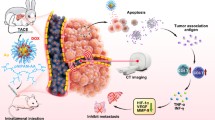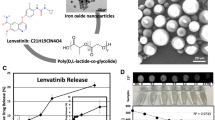Abstract
Purpose
Embolization is mainly used to reduce the size of locally advanced tumors. In this study, selective arterial catheterization with chitosan micro-hydrogels (CMH) into the femoral artery was performed and the therapeutic effect was validated using different imaging methods.
Methods
Male SD rats (n = 18, 6 weeks old) were randomly assigned into three groups: Group 1 as control, Group 2 without any ligation of distal femoral artery, and Group 3 with temporary ligation of the distal femoral artery. RR1022 sarcoma cell lines were inoculated into thigh muscle. After 1 week, CMH was injected into the proximal femoral artery. Different imaging modalities were performed during a 3-week follow-up.
Results
The tumor size was significantly (P < 0.001) decreased in both Group 2 and Group 3 (P < 0.001) after selective arterial embolization therapy. 18F-FDG-PET/CT revealed decreased intensity of 18F-FDG uptake in tumors. The accumulation status of 125I-CMH near the tumor was verified by gamma camera.
Conclusions
Appropriate selective arterial embolization therapy with CMH was.









Similar content being viewed by others
References
Yao FY, Kerlan Jr RK, Hirose R, Davern 3rd TJ, Bass NM, Feng S, et al. Excellent outcome following down-staging of hepatocellular carcinoma prior to liver transplantation: an intention-to-treat analysis. Hepatology. 2008;48:819–27.
Kneuertz PJ, Marsh JW, de Jong MC, Covert K, Hyder O, Hirose K, et al. Improvements in quality of life after surgery for benign hepatic tumors: Results from a dual center analysis. Surgery. 2012;152:193–201.
Garvey EM, Gray RJ, Wasif N, Casey WJ, Rebecca AM, Kreymerman P, et al. Neoadjuvant therapy and breast cancer surgery: a closer look at postoperative complications. Am J Surg. 2013;206:894–8.
J-P G’r, Azria D, Gourgou-Bourgade S, et al. Comparison of two neoadjuvant chemoradiotherapy regimens for locally advanced rectal cancer: Results of the phase III trial ACCORD 12/0405-Prodige 2. J Clin Oncol. 2010;28:1638–44.
Aschele C, Cionini L, Lonardi S, et al. Primary tumor response to preoperative chemoradiation with or without oxaliplatin in locally advanced rectal cancer: Pathologic results of the STAR-01 randomized phase III trial. J Clin Oncol. 2011;29:2773–80.
Dewdney A, Cunningham D, Tabernero J, et al. Multicenter randomized phase II clinical trial comparing neoadjuvant oxaliplatin, capecitabine, and preoperative radiotherapy with or without cetuximab followed by total mesorectal excision in patients with high-risk rectal cancer (EXPERT-C). J Clin Oncol. 2012;30:1620–7.
Singla A, Deshaies EM, Melnyk V, Toshkezi G, Swarnkar A, Choi H, et al. Controversies in the role of preoperative embolization in meningioma management. Neurosurg Focus. 2013;35:E17.
Cheng X, Sun P, Hu QG, Song ZF, Xiong J, Zheng QC. Transarterial (chemo) embolization for curative resection of hepatocellular carcinoma: a systematic review and meta-analyses. J Cancer Res Clin Oncol. 2014;140:1159–70.
Leyon JJ, Littlehales T, Rangarajan B, Hoey ET, Ganeshan A. Endovascular embolization: review of currently available embolization agents. Curr Probl Diagn Radiol. 2014;43:35–53.
Wang JJ, Zeng ZW, Xiao RZ, Xie T, Zhou GL, Zhan XR, et al. Recent advances of chitosan nano particles as drug carriers. Int J Nanomedicine. 2011;6:765–74.
Chae MJ, Lee ST, Kim JY, Woo GS, Jung WS, Chun KS, et al. Small Animal PET Imaging with [124I] FIAU for Herpes Simplex Virus Type 1 Thymidine Kinase Gene Expression in a Hepatoma Model. Nucl Med Mol Imaging. 2008;42:235–45.
Lin CY, Chen JH, Liang JA, Lin CC, Jeng LB, Kao CH. 18 F-FDG PET or PET/CT for detecting extrahepatic metastases or recurrent hepatocellular carcinoma: a systematic review and meta-analysis. Eur J Radiol. 2012;81:2417–22.
Addley HC, Griffin N, Shaw AS, Mannelli L, Parker RA, Aitken S, et al. Accuracy of hepatocellular carcinoma detection on multidetector CT in a transplant liver population with explant liver correlation. Clin Radiol. 2011;66:349–56.
Ma X, Liu Z, Yang X, Gao Q, Zhu S, Qin C, et al. Dual-modality monitoring of tumor response to cyclophosphamide therapy in mice with bioluminescence imaging and small-animal positron emission tomography. Mol Imaging. 2011;10:278–83.
Thompson SM, Callstrom MR, Knudsen B, Anderson JL, Butters KA, Grande JP, et al. AS30D model of hepatocellular carcinoma: tumorigenicity and preliminary characterization by imaging, histopathology, and immunohistochemistry. Cardiovasc Intervent Radiol. 2013;36:198–203.
Gutzeit A, van Schie B, Schoch E, Hergan K, Graf N, Binkert CA. Feasibility and safety of vascular closure devices in an antegrade approach to either the common femoral artery or the superficial femoral artery. Cardiovasc Intervent Radiol. 2012;35:1036–40.
Oliva MR, Saini S. Liver cancer imaging: role of CT, MRI, US and PET. Cancer Imaging. 2004. doi:10.1102/1470-7330.2004.0011.
Weber W, Weber J, Senekowitsch-Schmidtke R. Therapeutic effect of m-[131I]- and m-[125I] iodobenzylguanidine on neuroblastoma multicellular tumor spheroids of different sizes. Cancer Res. 1996;56:5428–34.
Maini CL, Scelsa MG, Fiumara C, Tofani A, Sciuto R, Tipaldi L, et al. Superselective intra-arterial radiometabolic therapy with I-131 lipiodol in hepatocellular carcinoma. Clin Nucl Med. 1996;21:221–6.
Acknowledgments
This research was supported by National Research Foundation of Korea and funded by the Ministry of Science, ICT and Future Planning; 2012M2A2A7014020, 2012M2A2A7035779 and 2011-0028581.
Ethical Statement
This study was approved by the animal ethics committee in our hospital and performed in accordance with the ethical standards laid down in the 1964 Declaration of Helsinki and its later amendments.
Conflict of Interest
Tai Kyoung Lee, JeongIl Kwon, Kyung Sook Na, Hwan-Seok Jeong, Hyosook Hwang, Phil-Sun Oh, Dong Hyun Kim, Kyu Yun Jang, Seok Tae Lim, Myung-Hee Sohn, Hwan-Jeong Jeong declare that they have no conflict of interest.
Author information
Authors and Affiliations
Corresponding author
Rights and permissions
About this article
Cite this article
Lee, T.K., Kwon, J., Na, K.S. et al. Evaluation of Selective Arterial Embolization Effect by Chitosan Micro-Hydrogels in Hindlimb Sarcoma Rodent Models Using Various Imaging Modalities. Nucl Med Mol Imaging 49, 191–199 (2015). https://doi.org/10.1007/s13139-014-0316-y
Received:
Revised:
Accepted:
Published:
Issue Date:
DOI: https://doi.org/10.1007/s13139-014-0316-y




